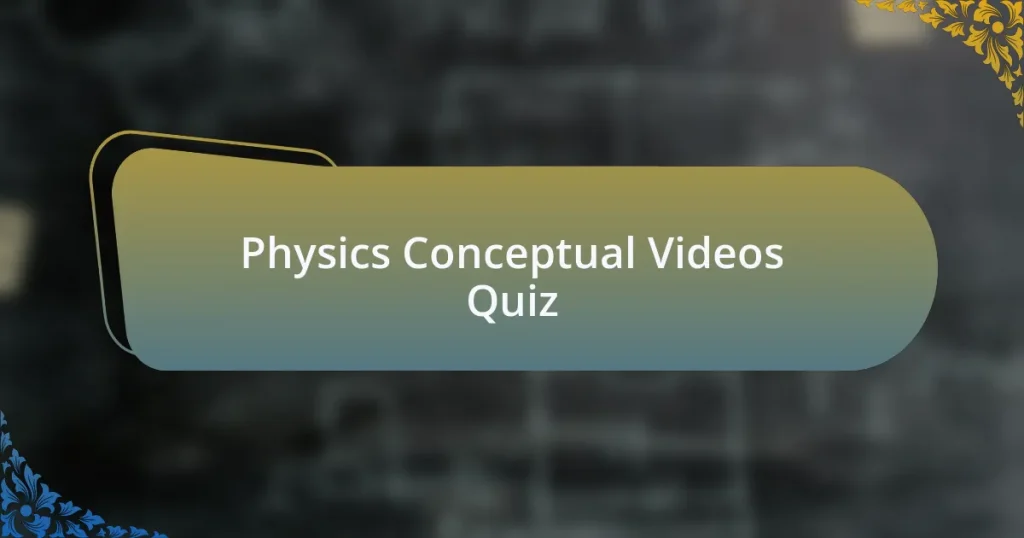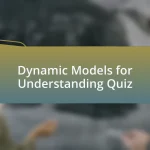Start of Physics Conceptual Videos Quiz
1. What is the formula for calculating kinetic energy?
- KE = 1/2 mv²
- KE = m²v
- KE = mv²
- KE = mv/2
2. What is the principle behind Archimedes` principle?
- An object sinks if its density is greater than the fluid.
- The pressure at a point in a fluid increases with depth.
- The buoyant force acting on a submerged object is equal to the weight of the fluid displaced by that object.
- Buoyancy is caused by the temperature of the fluid.
3. How do you define acceleration?
- Acceleration is defined as the rate of change of velocity over time.
- Acceleration is the total distance covered by an object.
- Acceleration is the force applied to an object divided by its mass.
- Acceleration is the constant speed of an object in motion.
4. What is the characteristic of a wave`s amplitude?
- The amplitude of a wave measures the wavelength of the wave.
- The amplitude of a wave shows the speed of wave propagation.
- The amplitude of a wave indicates its frequency of oscillation.
- The amplitude of a wave represents its maximum displacement from the rest position.
5. What does the photon model of light explain?
- The interference of light waves.
- The bending of light in a prism.
- The behavior of light as particles called photons.
- The reflection of light off surfaces.
6. What is the relationship between voltage, current, and resistance known as?
- Coulomb`s Law
- Faraday`s Law
- Kirchhoff`s Law
- Ohm`s Law
7. What is the phenomenon of electrons moving through a conductor called?
- Capacitance
- Current
- Resistance
- Voltage
8. What does the number of protons in an atom determine?
- The number of neutrons in the nucleus.
- The atomic number of an element.
- The energy levels of electrons.
- The molecular weight of a compound.
9. What is the process called when a liquid turns into vapor?
- Condensation
- Sublimation
- Solidification
- Vaporization
10. What type of wave requires a medium for propagation?
- Sound wave
- Mechanical wave
- Gravitational wave
- Electromagnetic wave
11. What is the term for the energy stored in an object`s position?
- Kinetic energy
- Potential energy
- Mechanical energy
- Thermal energy
12. How does a pendulum demonstrate the concept of simple harmonic motion?
- A pendulum demonstrates simple harmonic motion because it has a constant speed throughout its swing.
- A pendulum exhibits simple harmonic motion due to its restoring force proportional to its displacement.
- A pendulum displays simple harmonic motion as it relies on friction to return to its equilibrium position.
- A pendulum shows simple harmonic motion because it moves in a circular path without any restoring force.
13. What is the unit of measure for electric charge?
- Volt
- Ohm
- Coulomb
- Ampere
14. What does Hislaw`s principle describe in relation to fluids?
- It describes the behavior of fluids under static conditions.
- It describes the thermal conductivity of materials.
- It describes the behavior of solids under tension.
- It describes the motion of gases in a vacuum.
15. What does the term `elasticity` refer to in materials?
- The ability of a material to return to its original shape after being deformed.
- The property of a solid to remain rigid under stress.
- The ability to conduct electricity without resistance.
- The capacity of a material to absorb energy permanently.
16. How does sound travel in different mediums?
- Sound travels fastest in solids.
- Sound travels fastest in vacuums.
- Sound travels fastest in gases.
- Sound travels fastest in liquids.
17. What is the term for the energy of an object due to its motion?
- Potential energy
- Kinetic energy
- Chemical energy
- Thermal energy
18. What defines a perfect conductor in terms of electrical resistance?
- A perfect conductor has infinite electrical resistance.
- A perfect conductor has high electrical resistance.
- A perfect conductor has zero electrical resistance.
- A perfect conductor has fluctuating electrical resistance.
19. What is the effect observed when waves pass through a narrow opening?
- Diffraction
- Absorption
- Refraction
- Reflection
20. What is the photoelectric effect?
- The photoelectric effect is the reflection of light off a surface.
- The photoelectric effect is the scattering of light through a medium.
- The photoelectric effect is the emission of electrons from a material when it absorbs light of sufficient energy.
- The photoelectric effect is the absorption of heat by a material.
21. What does a trampoline demonstrate regarding potential and kinetic energy?
- A trampoline illustrates how energy is destroyed during use.
- A trampoline demonstrates the conversion between potential and kinetic energy.
- A trampoline only shows how to bounce higher without energy change.
- A trampoline proves that energy conversion is not possible.
22. How is the Doppler effect perceived in sound waves?
- The frequency of the sound remains constant regardless of movement.
- The volume of the sound increases as the source approaches.
- The pitch of the sound changes as the source moves closer or farther away.
- The sound wave stops when the source is stationary.
23. What does the term `quantum entanglement` refer to?
- Quantum entanglement refers to particles being separated by large distances with no effects on each other.
- Quantum entanglement describes the interaction between electric and magnetic fields in a vacuum.
- Quantum entanglement is a phenomenon where particles become interconnected and the state of one instantly influences the state of another, regardless of distance.
- Quantum entanglement is the process by which particles are emitted from a black hole.
24. What is the significance of Newton`s First Law of Motion?
- It states that for every action, there is an equal and opposite reaction.
- It describes the relationship between force and mass.
- It states that an object at rest stays at rest and an object in motion stays in motion unless acted upon by an external force.
- It defines the concept of energy conservation.
25. In what way does temperature affect gas pressure?
- Gas pressure increases with temperature.
- Temperature has no effect on gas pressure.
- Gas pressure remains constant regardless of temperature changes.
- Gas pressure decreases with temperature.
26. What does the term `dark matter` signify in cosmology?
- Dark matter is a visible substance made up of gas and dust in the universe.
- Dark matter is a type of energy that powers stars.
- Dark matter is a form of matter that does not emit or interact with electromagnetic radiation, making it invisible and detectable only through its gravitational effects.
- Dark matter is the light emitted by galaxies and stars.
27. What principle explains why hot air rises?
- Convection
- Reflection
- Conduction
- Radiation
28. What is the significance of the speed of light in physics?
- The speed of light is a fundamental constant that sets the maximum speed for all matter and information in the universe.
- The speed of light determines the weight of objects in motion.
- The speed of light is only relevant in quantum mechanics for particle behavior.
- The speed of light is used to measure the temperature of objects.
29. What does Ohm`s Law relate to in electric circuits?
- Only current in an electric circuit
- Only resistance in an electric circuit
- Only voltage in an electric circuit
- Voltage, current, and resistance in an electric circuit
30. What is a black body in terms of thermal radiation?
- A surface that absorbs no radiation but emits heat.
- An object that reflects all incident radiation perfectly.
- A perfect absorber and emitter of radiation at all wavelengths.
- A body that emits radiation only in the ultraviolet range.
Congratulations on Completing the Physics Conceptual Videos Quiz!
You’ve made it through the quiz on Physics Conceptual Videos! This engaging experience has not only tested your knowledge but also deepened your understanding of key physics concepts. Each question was designed to challenge your thinking and help you grasp complex ideas. We hope you enjoyed the process and found it both enlightening and fun.
As you reflect on your answers, consider the valuable insights you gained. Perhaps you discovered new ways to visualize concepts like force, energy, and motion. You may have also learned how these concepts apply to real-world situations. This knowledge will undoubtedly serve you well in your physics studies and test preparations.
Ready to expand your knowledge even further? We invite you to explore the next section on this page, where you’ll find more information about Physics Conceptual Videos. This resource will enhance your learning and prove beneficial as you prepare for your physics assessments. Dive in and continue your journey to mastery in physics!
Physics Conceptual Videos
Overview of Physics Conceptual Videos
Physics conceptual videos are educational resources designed to illustrate complex physics concepts visually. They cater to learners by breaking down theories, laws, and mathematical principles. By using animations, real-life examples, and visual aids, these videos enhance understanding. Research indicates that visual learning can significantly improve retention and comprehension in students. This makes conceptual videos effective tools in the study of physics.
Benefits of Using Physics Conceptual Videos in Test Preparation
Incorporating physics conceptual videos into test preparation offers multiple advantages. They simplify difficult topics, making them more accessible to diverse learners. Visual clarifications help students grasp abstract concepts like force, energy, and motion. Additionally, videos often provide step-by-step problem-solving methods, enhancing critical thinking skills. Reviews show that students who use these videos perform better on exams due to improved clarity and engagement.
Popular Platforms for Physics Conceptual Videos
Several platforms host a wide variety of physics conceptual videos. Websites like YouTube, Khan Academy, and Coursera are notable examples. Each platform offers specialized content suited for different learning levels. For instance, Khan Academy includes structured courses and practice exercises. YouTube features channels focused exclusively on physics, catering to diverse learning styles. This variety supports learners in finding the resources best suited to their needs.
Effective Strategies for Integrating Videos into Study Routines
To maximize the benefits of physics conceptual videos, students should adopt effective study strategies. Watching videos before class can prime learners for upcoming topics. Note-taking during viewings reinforces understanding and retention. After watching, students should attempt practice problems related to the concepts covered. This combination of visual learning and active problem-solving consolidates knowledge and enhances test readiness.
Evaluating the Quality of Physics Conceptual Videos
Assessing the quality of physics conceptual videos is crucial for effective learning. Sources should be reputable, featuring content created by experts in the field. The clarity of explanations and the accuracy of information are essential criteria. Well-structured videos typically include summaries or quizzes to reinforce learning. Student reviews and ratings can also serve as indicators of a video’s effectiveness and reliability in conveying concepts.
What are Physics Conceptual Videos?
Physics conceptual videos are educational tools designed to explain key physics concepts through visual illustrations and verbal explanations. They utilize animations, diagrams, and real-world examples to simplify complex topics. Research indicates that visual learning can enhance understanding; for instance, a study by the Journal of Educational Psychology demonstrates that students who engage with visual materials retain 30% more information than those who rely solely on text-based resources.
How can Physics Conceptual Videos aid in test preparation?
Physics conceptual videos aid in test preparation by breaking down challenging topics into manageable segments, making them easier to grasp. They allow learners to visualize abstract concepts like force, energy, and motion. Additionally, studies show that students who use multimedia resources, including videos, improve their problem-solving skills, as demonstrated by the analysis published in Physics Education research. This is essential for mastering test questions.
Where can students find reliable Physics Conceptual Videos?
Students can find reliable physics conceptual videos on various platforms, such as educational websites like Khan Academy, YouTube channels dedicated to science education, and institution-hosted resources. For example, channels like Veritasium and MinutePhysics are well-regarded for their accurate and engaging physics content, maintaining a high educational standard as evidenced by their substantial subscriber counts and positive user reviews.
When should students utilize Physics Conceptual Videos during their study routine?
Students should utilize physics conceptual videos during their study routine primarily when introducing new topics or reviewing difficult concepts. Integrating videos during study sessions reinforces learning and clarifies misunderstandings. Studies in cognitive science support this approach, revealing that the dual coding theory enhances retention when learners engage with both visual and verbal materials simultaneously.
Who benefits the most from Physics Conceptual Videos?
Students at various educational levels benefit the most from physics conceptual videos, particularly high school and college students preparing for physics exams. These videos cater to different learning styles, especially visual and auditory learners. A survey by the National Science Foundation highlighted that 65% of students preferred video explanations for complex topics, indicating a strong demand for such resources in test preparation.















